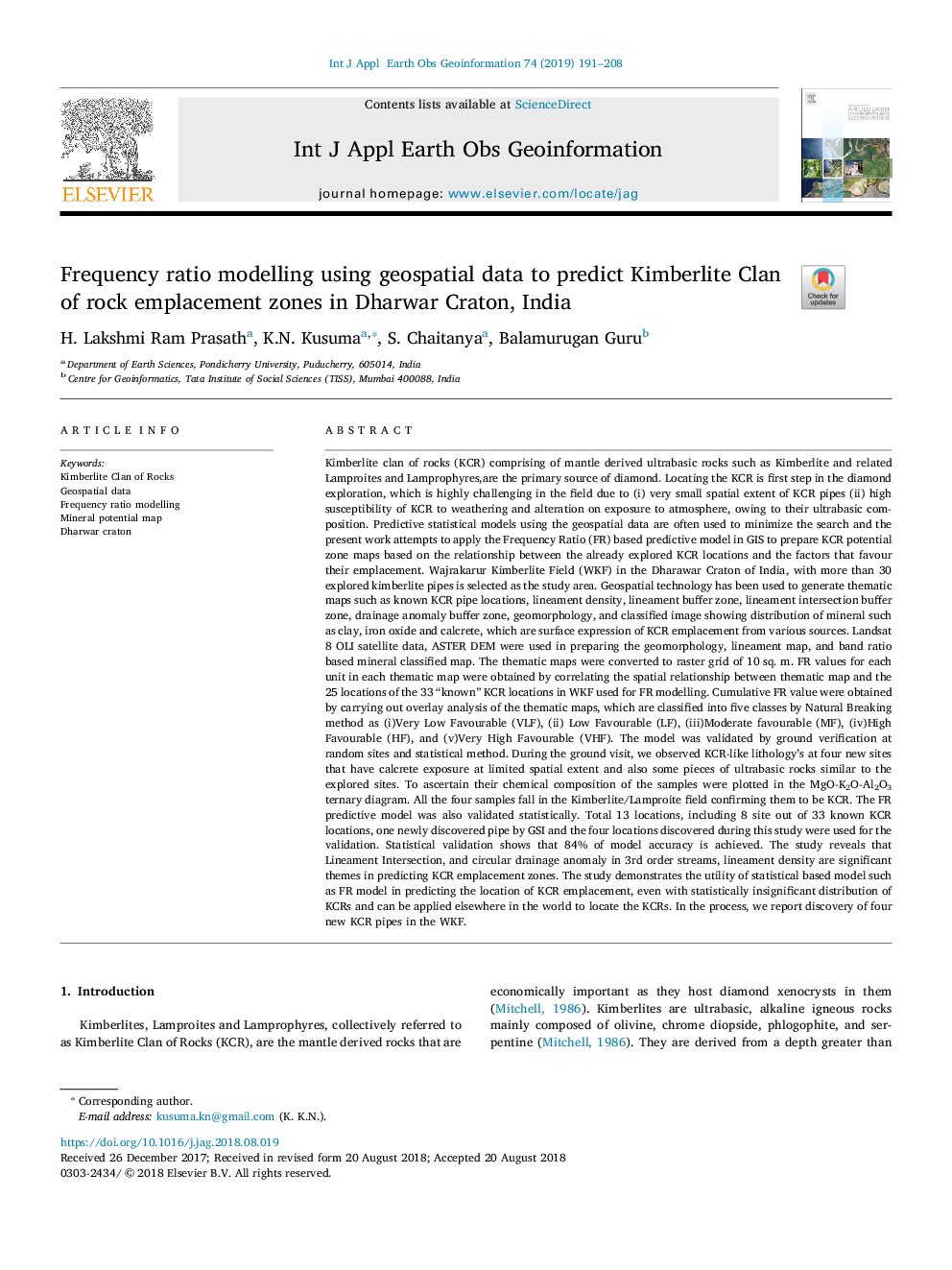| کد مقاله | کد نشریه | سال انتشار | مقاله انگلیسی | نسخه تمام متن |
|---|---|---|---|---|
| 11028671 | 1646758 | 2019 | 18 صفحه PDF | دانلود رایگان |
عنوان انگلیسی مقاله ISI
Frequency ratio modelling using geospatial data to predict Kimberlite Clan of rock emplacement zones in Dharwar Craton, India
ترجمه فارسی عنوان
مدل سازی نسبت فرکانس با استفاده از داده های جغرافیایی برای پیش بینی کیمبرلیت ها در مناطق جا به جایی سنگ در دورار کاتتون، هند
دانلود مقاله + سفارش ترجمه
دانلود مقاله ISI انگلیسی
رایگان برای ایرانیان
کلمات کلیدی
سنگ کیمبرلیت، داده های جغرافیایی، مدل سازی فرکانس، نقشه پتانسیل معدنی، قرطار کراتون،
موضوعات مرتبط
مهندسی و علوم پایه
علوم زمین و سیارات
کامپیوتر در علوم زمین
چکیده انگلیسی
Kimberlite clan of rocks (KCR) comprising of mantle derived ultrabasic rocks such as Kimberlite and related Lamproites and Lamprophyres,are the primary source of diamond. Locating the KCR is first step in the diamond exploration, which is highly challenging in the field due to (i) very small spatial extent of KCR pipes (ii) high susceptibility of KCR to weathering and alteration on exposure to atmosphere, owing to their ultrabasic composition. Predictive statistical models using the geospatial data are often used to minimize the search and the present work attempts to apply the Frequency Ratio (FR) based predictive model in GIS to prepare KCR potential zone maps based on the relationship between the already explored KCR locations and the factors that favour their emplacement. Wajrakarur Kimberlite Field (WKF) in the Dharawar Craton of India, with more than 30 explored kimberlite pipes is selected as the study area. Geospatial technology has been used to generate thematic maps such as known KCR pipe locations, lineament density, lineament buffer zone, lineament intersection buffer zone, drainage anomaly buffer zone, geomorphology, and classified image showing distribution of mineral such as clay, iron oxide and calcrete, which are surface expression of KCR emplacement from various sources. Landsat 8 OLI satellite data, ASTER DEM were used in preparing the geomorphology, lineament map, and band ratio based mineral classified map. The thematic maps were converted to raster grid of 10 sq. m. FR values for each unit in each thematic map were obtained by correlating the spatial relationship between thematic map and the 25 locations of the 33 “known” KCR locations in WKF used for FR modelling. Cumulative FR value were obtained by carrying out overlay analysis of the thematic maps, which are classified into five classes by Natural Breaking method as (i)Very Low Favourable (VLF), (ii) Low Favourable (LF), (iii)Moderate favourable (MF), (iv)High Favourable (HF), and (v)Very High Favourable (VHF). The model was validated by ground verification at random sites and statistical method. During the ground visit, we observed KCR-like lithology's at four new sites that have calcrete exposure at limited spatial extent and also some pieces of ultrabasic rocks similar to the explored sites. To ascertain their chemical composition of the samples were plotted in the MgO-K2O-Al2O3 ternary diagram. All the four samples fall in the Kimberlite/Lamproite field confirming them to be KCR. The FR predictive model was also validated statistically. Total 13 locations, including 8 site out of 33 known KCR locations, one newly discovered pipe by GSI and the four locations discovered during this study were used for the validation. Statistical validation shows that 84% of model accuracy is achieved. The study reveals that Lineament Intersection, and circular drainage anomaly in 3rd order streams, lineament density are significant themes in predicting KCR emplacement zones. The study demonstrates the utility of statistical based model such as FR model in predicting the location of KCR emplacement, even with statistically insignificant distribution of KCRs and can be applied elsewhere in the world to locate the KCRs. In the process, we report discovery of four new KCR pipes in the WKF.
ناشر
Database: Elsevier - ScienceDirect (ساینس دایرکت)
Journal: International Journal of Applied Earth Observation and Geoinformation - Volume 74, February 2019, Pages 191-208
Journal: International Journal of Applied Earth Observation and Geoinformation - Volume 74, February 2019, Pages 191-208
نویسندگان
H. Lakshmi Ram Prasath, K.N. Kusuma, S. Chaitanya, Balamurugan Guru,
